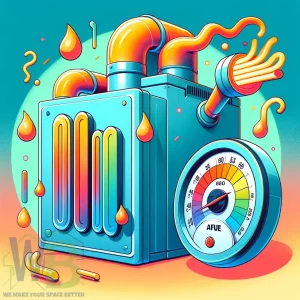CFM stands for Cubic Feet per Minute, a key measure to determine how much air an HVAC system can move.
This article breaks down the concept of CFM, its importance in HVAC, and how it’s calculated.

Quick Summary
| Section | Key Points |
|---|---|
| What is CFM? | – CFM stands for Cubic Feet per Minute. – Measures air volume flow rate in HVAC systems. |
| CFM per BTU | – Relationship between air flow (CFM) and heating/cooling capacity (BTU). – Important for system efficiency. |
| Importance of CFM in HVAC | – Critical for air quality, comfort, and energy efficiency. – Affects design and sizing of HVAC systems. |
| How to Calculate CFM | – Involves room measurements and air changes per hour. – Formula: CFM = (Room Volume x ACH) / 60. |
| CFM to PSI Formula | – Used in context of air compressors. – Depends on tank size and standard pressure. |
| Conclusion | – CFM is a fundamental concept in HVAC. – Impacts system design, performance, and efficiency. |
What is CFM in HVAC?
CFM, or Cubic Feet per Minute, measures the volume of air an HVAC system moves in one minute. It’s vital in evaluating the efficiency and suitability of a heating, cooling, or ventilation system for a specific area.
Having the correct CFM is crucial for an HVAC system. It helps the system manage the airflow needed for a space. This means it can give good ventilation and keep the temperature comfortable.
Key Points:
- Definition: CFM measures air volume flow rate.
- Significance: Determines the HVAC system’s ability to ventilate a space.
- Measurement: Based on the cubic feet of air moved per minute.
Knowing CFM is key to choosing the best heating, ventilation, and air conditioning (HVAC) systems. It helps keep the air fresh and comfortable in houses and buildings.
CFM per BTU
The relationship between CFM (Cubic Feet per Minute) and BTU (British Thermal Unit) is significant in HVAC systems.
BTU measures the heat required to raise the temperature of one pound of water by one degree Fahrenheit. In HVAC, it’s used to quantify the heating or cooling capacity of a system.
Understanding the CFM/BTU Ratio:
- Heating and Cooling Capacity: BTU indicates how much heat can be added or removed.
- Air Flow Needs: CFM provides the airflow required to distribute this heat or cooling evenly.
For efficient operation, a general rule is that an HVAC system needs about 400 CFM per 12,000 BTU per hour of cooling capacity. This ratio ensures adequate airflow for temperature regulation.
Why It Matters:
- Efficiency: Proper CFM/BTU balance leads to energy-efficient operation.
- Comfort: Ensures even temperature distribution in a space.
Maintaining this balance is key for an HVAC system’s performance, affecting energy costs and comfort levels.
Importance of Cubic Feet Per Minute in HVAC
Cubic Feet per Minute (CFM) plays an important role in the functionality and efficiency of HVAC systems. Understanding its importance helps maintain, design, and optimize these systems for better performance and comfort.
Why CFM Matters:
- Air Quality: Adequate CFM ensures proper air circulation, reduces pollutants, and maintains healthy indoor air quality.
- Comfort: Correct CFM levels help maintain consistent temperature and humidity levels.
- System Efficiency: Optimizing CFM can save energy and prolong equipment life.
Impact on HVAC Systems:
- Sizing: Ensures HVAC units are correctly sized for a given space.
- Ductwork Design: Influences the design and layout of ducts for effective air distribution.
- Energy Consumption: Affects the system’s energy use and operational costs.
CFM is a cornerstone in HVAC design and operation, influencing everything from air quality to energy efficiency.
How to Calculate CFM
Calculating CFM (Cubic Feet per Minute) for HVAC systems is essential for ensuring efficient and effective heating, cooling, and ventilation.
The process involves a few steps and considerations to determine the CFM needed for a specific space accurately.
Steps to Calculate CFM:
- Measure Room Size: Calculate the volume of the room by multiplying its length, width, and height.
- Determine Air Changes per Hour (ACH): Decide how often you want the air in the room to be replaced or circulated in an hour.
- Use the CFM Formula: Multiply the room volume by the ACH and divide by 60 (to convert hours to minutes).CFM = (Room Volume x ACH) / 60
Considerations:
- Room Use: Different spaces require different ACH rates based on usage and occupancy.
- Climate: Factors like humidity and temperature also affect CFM calculations.
- System Type: Different HVAC systems may have unique CFM requirements.
Accurate CFM calculations are crucial for effective HVAC system design, ensuring optimal performance and comfort.
CFM to PSI Formula in HVAC
The relationship between CFM (Cubic Feet Per Minute) and PSI (Pounds per Square Inch) is crucial in the context of HVAC, especially when it comes to understanding air compressors’ air output capacity. Here’s a more detailed look at the formula and its application:
Understanding the CFM to PSI Relationship:
- CFM: Measures the airflow volume per minute in cubic feet.
- PSI: Represents the air pressure in pounds per square inch.
Calculation Formula:
The formula to calculate CFM at a specific PSI in the context of an air compressor is given as:
CFM=Tank Volume in Cubic Feet×Standard Pressure (ATM) during a cycle×Cranks per Minute
This formula helps calculate the airflow output of an air compressor over a certain period.
The CFM value depends on tank volume, standard pressure, and the number of cranks per minute.
Additionally, for air compressors with different tank sizes, the conversion formula varies:
- For tank sizes of 1 to 5 gallons: PSI=(CFM×Tank Size)÷1.25PSI=(CFM×Tank Size) ÷ 1.25
- For tank sizes of 6 gallons or more: PSI=(CFM×Tank Size)÷2.5PSI=(CFM×Tank Size) ÷ 2.5
Application in HVAC:
- Air Compressors: This formula is specifically relevant for air compressors in HVAC systems.
- System Design: Helps in designing systems with appropriate air output capacity.
- Efficiency: Ensures the system operates efficiently at different pressure levels.
The CFM-to-PSI relationship and the appropriate formula are essential for accurately assessing and designing HVAC systems, particularly those involving air compressors.
Conclusion
In HVAC systems, CFM (Cubic Feet per Minute) is crucial for ensuring the system runs well. It’s used to work out the right airflow, understand how it connects with BTU for heating and cooling, and figure out CFM to PSI in air compressors. Knowing CFM well is important.
Key Takeaways:
- CFM’s Role: Air quality, comfort, and system efficiency are crucial.
- CFM Calculations: Accurate calculations are essential for system design and performance.
- CFM and BTU: Their interplay is important for heating and cooling efficiency.
- CFM to PSI Formula: This is particularly relevant in air compressors in HVAC systems.
CFM is a key idea in HVAC. It affects everything from how the system is made to how well it works. Knowing how to use CFM correctly can make HVAC systems work better.
This means cleaner air, more comfort, and less energy use.







